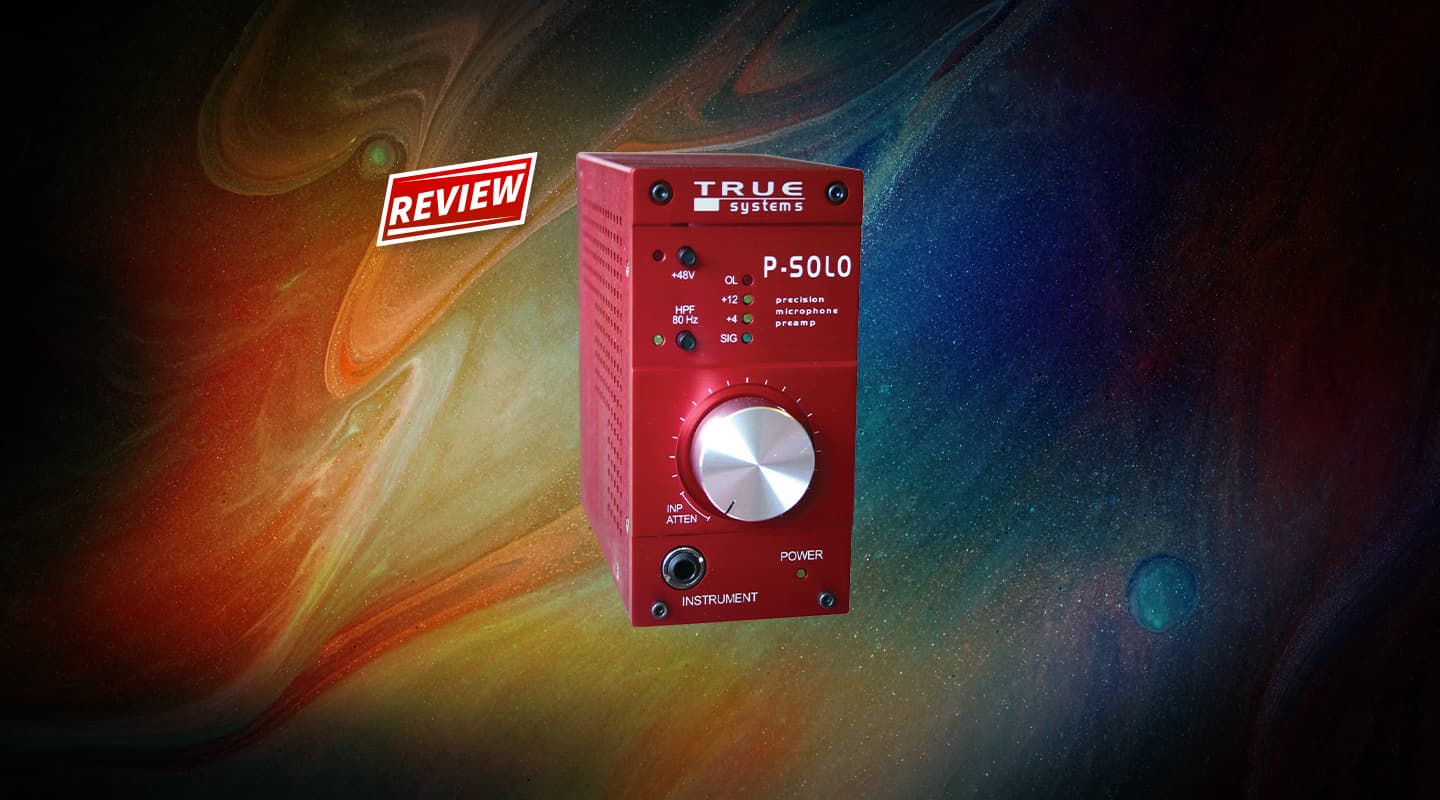
Review: True Systems P-Solo Microphone Preamp
Microphone preamps come in all shapes and sizes but the P-Solo stands alone, quite literally.
Review: Greg Walker
The True Systems P-Solo is a diminutive, stand-alone single-channel version of the Tucson, Arizona company’s well-regarded Precision 8 and P2analogue mic preamps. The P-Solo comes in a compact 8 x 15 x 15cm frame, weighs in at 2.3kg and is finished in red brushed aluminium with a single large silver rotary gain control dominating the front panel. The striking visuals are backed up by very solid overall build quality (the gain pot is silky smooth and a joy to operate) and the overall impression is of something quite a lot less toy-like than the photo might indicate. From top to bottom the front panel features push buttons for 48V power and high-pass filter (80Hz) – both functions indicated via LEDs when engaged. A four-segment LED provides simple metering from ‘signal detected’ through +4 and +12dB output level to overload (‘OL’).
The aforementioned rotary gain control provides a generous +15.5 to +65dB of microphone preamplification and –4 to +44dB for direct inputs. At the far counterclockwise end of this range the control clicks into input attenuation mode, providing a fixed +6dB of mic gain and –14dB of direct instrument gain for very hot signals. A 1/4-inch jack plug for DI’d instruments and a LED power indicator round out the front panel. The legending is clear but unobtrusive although the lack of any specific gain indicators or detents will make exact recalls difficult (out comes the chinagraph yet again!). The rear panel is similarly uncomplicated with standard XLRs for in/outs, an additional balanced TRS output and a small switch to fire up the internal power supply. Internally, the P-Solo utilises a high-voltage composite (discrete and IC) architecture with hand-matched, military grade components used in critical circuit areas. The manual claims the True Systems’ totally balanced, dual servo, DC-coupled design provides exceptional transient response, headroom, imaging and noise performance and certainly, with the published spec at –132dB EIN for noise and THD of 0.0008%… I for one wasn’t lying awake at night fretting about any noise or fuzziness emanating from this preamp.
SUBJECTIVE TRUTH
Testing preamps has to be one of the more tricky and subjective things we do here at AT. We don’t generally review anything that sounds like crap so it’s usually more a question of asking how much goodness is there in this thing for how much money. Clarity, sonic depth and power are probably the most important criteria to look at first, though of course, once you get into those elusive questions of ‘character’ things start to get a bit less clear cut.
To get to the heart of the matter I recorded a number of sources through different mics and put the P-Solo up against my trusty solid-state Universal Audio 2108 and the budget Focusrite preamps in my old Digi 001. I have to say the P-Solo did very well overall and, in my opinion, justified its $999 asking price. On acoustic guitar the P-Solo did a very good job of capturing an up-front sound through a small-diaphragm condenser with plenty of midrange tone and a nice sense of clarity up high. I recorded some vocals through an Octava ribbon mic and the P-Solo captured the full-bodied bottom end sound of the ribbon very well – a little top-end EQ boost revealed the lovely smooth top-end that any good ribbon captures – with the low noise and high gain capability of this preamp making it a real winner in these kinds of applications. Some dynamic mics on various drum kit sources showed the P-Solo to be well equipped for percussion work, with very good transient response and, again, clarity being the foremost attribute of the sound. Finally, directly plugging in an electric and bass guitar quickly showed a fairly neutral but very useable tone for DI’d sources, further cementing my impression of the P-Solo as a well designed and versatile performer on all kinds of sonic tasks. In fact, I was amazed at how similar some of the sounds were to the UA 2108 – one of my main go-to preamps when I want something to sound clear and up-front in a mix (vocals, percussion, guitars, strings etc.). The UA can be overdriven like a guitar amp, which the P-Solo obviously can’t, but at conservative settings the two were very similar, which is a big tick in the box for the P-Solo.
At around the $1000 mark it isn’t especially cheap but you should expect to pay this kind of money for something that doesn’t disappoint over a prolonged period of time. For me the P-Solo preamp definitely fits into the category of all-round workhorse. It doesn’t unduly colour the signal but provides a very transparent full-range sound with plenty of body and a nice clear top end. If you’re looking for something along these lines and you like its distinctive compact frame and design smarts, the True Systems P-Solo is definitely worth auditioning.
















RESPONSES